Silk Road
Q36288The Silk Road is the modern name for the network of trade routes between the Mediterranean Sea and China.
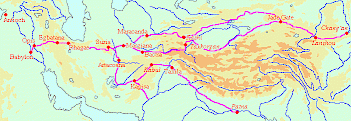
At the beginning of the sixth century BCE, the trade route that would later be known as Silk Road started in Babylon, from where it passed through Opis/Ctesiphon, Ecbatana (Hamadân) and modern Sâveh - the place where Marco Polo would one day see the tombs of the three Magi who had visited Jesus of Nazareth. Whatever the historical value of the story of the Magi, it is interesting that Polo places their tombs along the road they must have traveled when they were heading to the west.
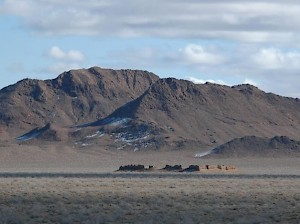
From Saveh, the road continued to Rhagae (south of modern Tehran), a religious center in ancient Media. Further to the east, it continued eastward, to Parthia (modern Khorasan), passing through Hecatompylos (Šahr-e Qûmes near Damghan) and Susia (Toos near Mashad). To the north, travelers saw the Elburz mountains, to the south, the desert.
At Susia, the road forked. The southeastern branch went through the Arian capital Artacoana (later known as Alexandria in Aria; modern Herat) to Kapisa (Alexandria in Arachosia; Kandahâr) in Arachosia, and from there either to the southeast to the Lower Indus or to the northwest to Gandara (the valley of the Kabul) and the Punjab.
The northern branch went from Susia through the Karakum desert, passing along the oasis Margiana (Mary or Merv) to Maracanda (Samarkand) in Sogdia. Maracanda, situated on the banks of the river Zeravshan ("rich in gold") was a center of tin production, a very important metal.
Another branch led to Bactra (Balkh, near modern Mazar-e Sharif) and Drapsaca (Konduz). Here, lapislazuli could be found, a precious article that was much appreciated in Babylonia and Assyria. Other articles that were traded were the famous "blood sweating" horses of the Ferghana valley, and hairy camels from the Gobi desert.
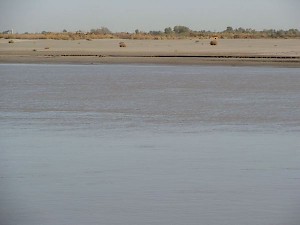
Almost no one traveled beyond Drapsaca, but a few continued upstream along the Amudar'ya. The most important towns along this road were modern Taloqan, Feyzabad, and Eshkashem. The traveler had now reached Wakshan, a small strip of land along the upper Amudar'ya, which is also called Ab-i-Panja. At the eastern end of this valley, he had to climb the Pamir mountains - the pass is 4,923 meters high - after which he reached a place named Stone Tower. It is probably identical to Taxkorgan and it seems to have been the place where westerners bartered their goods with the products from the Far East. Here, a second trade route joined the Silk road: across the Khunjerab pass, one could go to Kashmir and the capital of the Punjab, Taxila.
Another exchange point between westerners and Chinese was modern Kashi, an oasis in Xinjiang. It was reached by a more northerly branch of the Silk road.
When the Chinese traders went home, they first passed along the Desert Without Return (Taklamakan), obtained jade in Khotan, and reached the Jade Gate (Yumen), which is traditionally viewed as the western end of the Great Wall. From here, they continued to modern Lanzhou, from where they could go to Chang'an, the City of Eternal Peace, which may be regarded as the last station of the road.
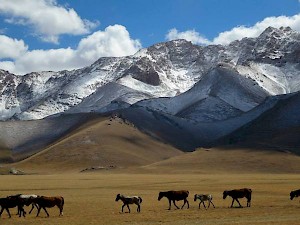
Chang'an was the capital of China under the rule of he emperors of the Han dynasty (206 BCE - 220 CE). Under the emperor Wu Di (141-87), the Silk road was really opened: from now on, the government would take care of it. Wu Di had to campaign against the Hsiung-nu nomads in the north - they are believed to be the ancestors of the Huns - and c.130 BCE he sent out his general Zang Qian to find allies and to buy the famous Iranian war horses from Nisaia. Although Zang Qian failed in his mission, he had visited Bactria and had found the way to the west.
Trade was made easier when the Chinese acquired Xinjiang (also called Chinese Turkestan) in 104-102 BCE. The caravans received some protection from the authorities for a substantial part of their route. Moreover, bridges and paved roads were constructed.
Beyond the Jade Gate, the political situation was more complex: the Pamirs were dominated by sometimes aggressive mountain tribes and the empires of the Parthians and Seleucids were fighting a more or less permanent war. Nonetheless, the Chinese received horses and other valuable articles - myrrh, frankincense, ostrich eggs, glass, furs, aloe, gemstones - from the west; and the Parthians, Seleucids, Greeks and Romans acquired ceramics and bales of silk, which had been carried by donkeys, mules, horses, yaks and camels for almost thousands of kilometers. (An overview of road stations can be found in the Mansiones Parthicae by Isidore of Charax.) Another product that came to the west was the walnut tree.
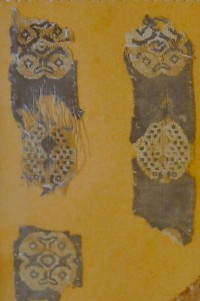
In the West, silk was considered more precious than gold and it remained very rare and expensive. To the best of our knowledge, the Roman emperor Heliogabalus (218-222) was the only Roman to wear a dress of pure silk. The westerners called the Chinese simply the Silk People (Seres); the capital of the Han dynasty, Chang'an, was known as Silk City.
When the Han dynasty collapsed in the third century, trade between east and west was reduced to a minimum. According to the Byzantine historian Procopius (c.500-c.570), two Christian monks discovered the secret of the silk production. The emperor Justinian (527-565) immediately dispatched secret agents to steal silkworm eggs and to bribe silk experts. They were successful, and from this time onward, silk was also produced in the Mediterranean.
This was not the end of the Silk Road, however, because the West remained interested in buying gums and spices. When the T'ang (618-907) dynasty restabilized China, the long-distance trade route was reanimated. It became a road to spread Christianity as well: in 635, Nestorian missionaries from Ctesiphon reached China. As we have already seen, its most famous traveler was Marco Polo, whose story is invaluable. The name Seidenstraße, "Silk Road", was coined in 1877 by German traveler Ferdinand von Richthoven.
Thanks...
... to Paul Lombard